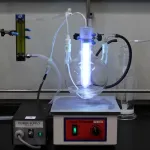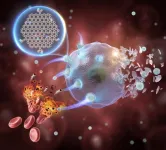(Press-News.org) Record heat across the world profoundly impacted the global water cycle in 2023, contributing to severe storms, floods, megadroughts and bushfires, new research from The Australian National University (ANU) shows.
The findings are outlined in a new report released today by the Global Water Monitor Consortium and led by ANU researchers.
Lead author Professor Albert Van Dijk, from ANU, said the report underscores the consequences of persistent fossil fuel burning on natural disasters, water resources, biodiversity and food security.
“Record-breaking heat waves swept across the globe in 2023, shattering previous records, from Canada to Brazil and from Spain to Thailand,” Professor Van Dijk said.
“The lack of rainfall and high temperatures exacerbated multi-year droughts in South America, the Horn of Africa and around the Mediterranean.
“Extremely hot and dry conditions inflicted extensive ecological damage on the world's largest forests. Massive wildfires ravaged Canada during the northern summer, while the Amazon rainforest and rivers rapidly descended into severe drought in late 2023.”
Some of the worst disasters of 2023 were linked to unusually strong cyclones bringing extreme rainfall to New Zealand, Mozambique and Malawi, Myanmar, Greece, Libya and Australia.
According to Professor van Dijk, who is also Chair of the Global Water Monitor Consortium, rising sea surface and air temperatures caused by fossil fuel burning have been intensifying the strength and rainfall intensity of monsoons, cyclones and other storm systems.
This was also evident closer to home, where Cyclone Jasper battered northern Queensland and severe storms hit southeast Queensland.
“Some areas around Cairns recorded more than 800 millimetres of rain. The torrential rains caused widespread flooding. That was because the cyclone moved much slower than expected,” he said.
“The recent cyclones and intensive storms in Queensland and elsewhere in Australia should not be seen as isolated freak events but part of a global pattern that was quite clear in 2023.
“In 2023, we saw cyclones behave in unexpected and deadly ways. The longest-lived cyclone ever recorded battered southeastern Africa for weeks.
“Warmer sea temperatures fuelled those freak behaviours, and we can expect to see more of these extreme events going forward.”
Professor van Dijk said the last two decades have seen increased air temperatures and declining air humidity, causing increased heat stress and water requirements for people, crops and ecosystems, while intensifying droughts.
Relative air humidity over the global land surface in 2023 was the second driest on record after 2021, continuing a trend towards drier and more extreme conditions. 2023 was Earth’s hottest year on record, showing what a typical future year with 1.5 degrees warming may look like.
“A total of 77 countries experienced the highest average annual temperature in at least 45 years,” Professor Van Dijk said.
Professor Van Dijk said 2023 was a year of extremes, with increasing extreme dry and wet conditions and more unprecedented weather events. This is in line with ongoing changes in the water cycle over the last two decades.
“The events of 2023 show how ongoing climate change is threatening our planet and lives more with every passing year,” he said.
“Globally, we’re seeing an increase in the frequency and intensity of rainfall events and river flooding. But at the same time, there are also more frequent and faster developing droughts, or ‘flash droughts’.
“That can cause crop failure and destructive wildfires in a matter of weeks or months. With the global food challenge, biodiversity crisis and an extremely urgent need to reduce carbon emissions, these droughts and wildfires are among our greatest global threats.”
The research team used data from thousands of ground stations and satellites orbiting the Earth to provide real-time information on rainfall, air temperature, air humidity, soil and groundwater conditions, vegetation, river flows, flooding, and lake volumes.
The Global Water Monitor is a collaboration between institutions across the world and involves various public and private organisations.
The 2023 report is available on the Global Water Monitor website.
END
Record heat in 2023 worsened global droughts, floods and wildfires
2024-01-10
ELSE PRESS RELEASES FROM THIS DATE:
MD Anderson research highlights for January 10, 2024
2024-01-10
HOUSTON ― The University of Texas MD Anderson Cancer Center’s Research Highlights showcases the latest breakthroughs in cancer care, research and prevention. These advances are made possible through seamless collaboration between MD Anderson’s world-leading clinicians and scientists, bringing discoveries from the lab to the clinic and back.
Recent developments at MD Anderson include insights into the effects of the gut microbiome on remote tumors, a screening strategy for ovarian cancer early detection, a combination approach ...
Newly identified genes for depression may lead to new treatments
2024-01-10
More than 200 genes linked to depression have been newly identified in a worldwide study led by UCL researchers.
The research, published in Nature Genetics, found more than 50 new genetic loci (a locus is a specific position on a chromosome) and 205 novel genes that are associated with depression, in the first large-scale global study of the genetics of major depression in participants of diverse ancestry groups.
The study also showcases potential for drug repurposing, as one of the identified genes encodes a protein targeted by a common diabetes drug, while also pointing to new targets for drugs that ...
In hot water: coral resilience in the face of climate change
2024-01-10
From intensifying wildfires to record-breaking floods year on year, the effects of climate change have manifested in devastating outcomes on ecosystems that threaten species all over the world. One such ecosystem in peril is coral reefs, which play a major role in sustaining biodiversity in the planet’s oceans but are facing increasingly severe conditions as waters heat up leading to a phenomenon known as marine heat waves.
For nearly a decade, Katie Barott, assistant professor of biology at the University ...
JMIR Aging accepted for inclusion in MEDLINE
2024-01-10
JMIR Publications is pleased to announce that JMIR Aging has been accepted for inclusion in MEDLINE, which is the U.S. National Library of Medicine's premier bibliographic database.
JMIR Aging had already been indexed in PubMed previously. MEDLINE is a more selective subset of PubMed, consisting of the top 5,200 biomedical journals. Indexing in MEDLINE also means that articles are now also indexed with NLM Medical Subject Headings (MeSH terms) and other metadata.
Selection for MEDLINE is a result of a thorough review of the journal by reviewers from the Literature ...
Dry-cleaning fluid becomes a synthetic chemist's treasure
2024-01-10
The widely used dry-cleaning and degreasing solvent perc can be converted to useful chemicals by a new clean, safe and inexpensive procedure. The Kobe University discovery using on-demand UV activation may open the path to upcycling perc and thus contribute to a more sustainable society.
Organic synthesis is the production of useful chemicals, such as drugs, from other available chemicals. In general, chemists use source materials to create simple building blocks, such as carbonate esters, and combine them to increasingly complex structures. The source materials for this need to be reactive, but that also usually makes them toxic, such as the commonly ...
Countries and companies need to address declining global fertility rates, doctors say
2024-01-10
The global fertility rate is declining and most governments are failing to recognize and address the impact on economies and societies, say a group of physicians invited by the International Federation of Fertility Societies (IFFS) in a new paper and campaign launched today.
“Not including the effects of migration, many countries are predicted to have a population decline of more than 50% from 2017 to 2100,” the physicians write in “Declining global fertility rates and the implications for family planning and family building,” published January 10, 2024 in Human Reproduction Update.
“By 2050, 77% of predominantly high-income countries, and ...
The reaction mechanism for catalytic ammonia production experimentally determined
2024-01-10
Researchers at Stockholm University have for the first time been able to study the surface of iron and ruthenium catalysts when ammonia is formed from nitrogen and hydrogen; the results are published in the scientific journal Nature. A better knowledge of the catalytic process and the possibility of finding even more efficient materials opens the door for a green transition in the currently very CO2-intensive chemical industry.
Ammonia, produced in the Haber-Bosch process, is currently one of the most essential base chemicals for the world to produce fertilizers, with an annual production of 110 million tones. The journal ...
Ancient DNA reveals reason for high multiple sclerosis and Alzheimer’s rates in Europe
2024-01-10
Researchers have created the world’s largest ancient human gene bank by analysing the bones and teeth of almost 5,000 humans who lived across western Europe and Asia up to 34,000 years ago.
By sequencing ancient human DNA and comparing it to modern-day samples, the international team of experts mapped the historical spread of genes – and diseases – over time as populations migrated.
The ‘astounding’ results have been revealed in four trailblazing research papers published today (10 January 2024) in the same issue of Nature and provide new ...
Noninvasive test for embryo quality could streamline fertility treatment
2024-01-10
In-vitro-fertilization (IVF), a fertility treatment that involves fertilizing eggs in the laboratory and later implanting them in the uterus, has been a source of hope for many people struggling to conceive. However, the multi-step process is complex, and the overall live birth rate after IVF treatment is only 20-40% in females younger than 40 in the United States. One of the reasons for this low success rate is that it’s very difficult for doctors to determine which lab-grown embryos are most likely to result in a successful pregnancy, so many people seeking IVF must go through multiple rounds of treatment.
Now, scientists at University of California San Diego School of ...
Metal-free graphene quantum dots show promise for highly efficient tumor therapy
2024-01-10
A research group led by Prof. WANG Hui from the Hefei Institutes of Physical Science (HFIPS) of the Chinese Academy of Sciences has introduced a metal-free nanozyme based on graphene quantum dots (GQDs) for highly efficient tumor chemodynamic therapy (CDT).
The study was published in Matter.
GQDs represent a promising and cost-effective means of addressing the toxicity concerns associated with metal-based nanozymes in tumor CDT. However, the limited catalytic activity of GQDs has posed significant challenges for their clinical application, particularly under challenging catalytic conditions.
"The obtained GQDs, which are made from red blood cell membranes, ...








